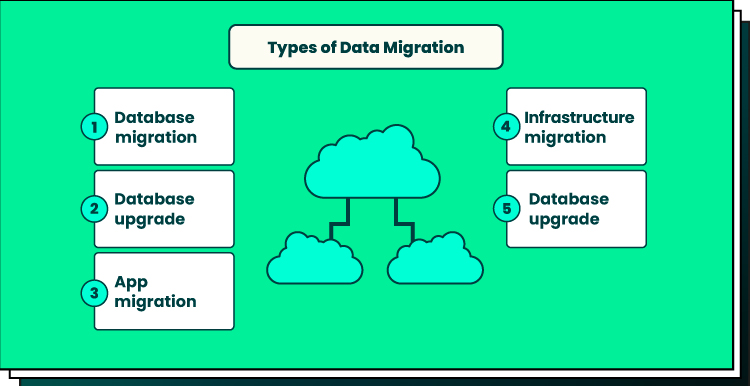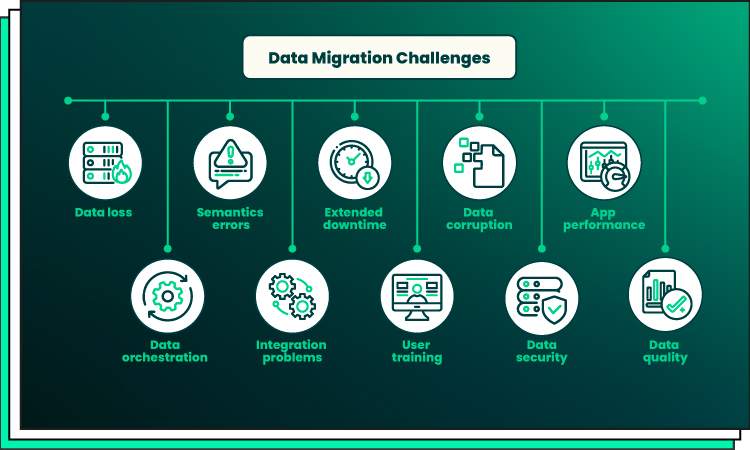Transitioning your data from one source to another seems a simple task. But not for businesses that daily collect big volumes of structured and unstructured data. According to Oracle, more than 80% of data migration projects fail to meet deadlines or stick to the budget. One of the top 4 reasons for this happening is that companies neglect data migration challenges and cannot handle the damage these risks bring to their projects.
If you are determined to change this tendency and complete your data migration on time and according to your budget, this article is for you.
Today, we will explore the top 10 data migration challenges and the solutions to overcome them. Keep reading to learn what successful data migration is, what data migration types exist, and how to minimize major data migration risks that can affect your budget and performance.
What Is Data Migration?
Data migration is the process of transferring your data from one system to another. The system your data is supposed to migrate to is called the target system. The data migration process involves the use of certain data migration approaches, principles, and techniques that help companies prevent data loss and minimize risks in data migration. Check out our blog to discover the difference between data migration and data conversion.

Here are some factors that should be considered when planning data migration.
- Data volume. If you plan to migrate a limited volume of data (for example, up to 10 terabytes), this can be done simply and quickly. However, if your company’s data exceeds the petabyte, you will likely need to involve special data migration tools. This will help you minimize the migration risks and data migration efforts and ensure that the process runs smoothly.
- Workload type. The type of workload will shape the data migration strategy. If you are leveraging specialized data types (such as virtual machines or databases), you can use the tools that are usually provided by the software vendors. If you migrate data that is mission-critical, try to break the process into several stages. Otherwise, plan the migration to be done when your business and your clients are inactive (for example, during the night hours).
- The optimal timeline for the project. The more time you dedicate to the project, the less disruptive the migration will be. Define the scope of time and budget you are ready to invest in data migration. It will help your software vendors plan the process securely and with no risks.
Major Data Migration Types
Here are the common 5 types of data migration projects:

Database migration
Under this data migration process, you move your data from one database to another. For example, you decide to move your data from PostgreSQL to MySQL. Typically, migrating existing data from one database to another does not involve changing the structure of data. Before choosing the database, you need to check if its size matches your expectations. Also, consider how critical data will be protected in this database. To eliminate data migration challenges, assess the database by testing it with test apps.
Database upgrade
This involves transitioning your data from the old version to the new version of the same database. This decision can be caused by the fact that the older versions will no longer be supported, or that the new version offers more benefits for businesses.
An example of a database upgrade is moving from Universal Analytics to Google Analytics 4. Starting from July 2023, Universal Analytics will stop processing data. It will be replaced by the next-gen Google Analytics 4. The property will automatically be created for businesses that have been using Universal Analytics before. Businesses will continue to collect data in a new upgraded Analytics version. But what should they do with historical data stored in the previous version? According to Google, they will be able to access it for nearly 6 months. Then, the data will be unavailable to users. Therefore, Google encourages businesses to export their historical data to the upgraded solution.
Contact Forbytes if you need help with this process. Recently, we completed the same project for one of our biggest clients — an ecommerce enterprise. We securely migrated data to a new data warehouse to preserve historical reports and eliminate any risks.
App migration
This is migrating your application from one framework to another. This process involves changing the model of data, which is usually unique for every application. To perform successful migration of this type, you should make sure that the data formats are communicable between the two solutions. If you migrate incompatible data, you increase the risks of data loss.
Infrastructure migration
This data migration type involves migrating the whole infrastructure that consists of solutions, data systems, applications, etc. The most popular example of infrastructure migration is migrating from on-premises to the cloud. Because of the low maintenance costs and effort, more and more companies move their business ecosystem to the cloud. By leveraging effective cloud migration strategies, they cut expenses, prevent data damage, and ensure data integrity as well as real-time access for all stakeholders.
Storage migration
Storage migration is when you change the storage space where your existing data is kept. Data migrations of this type involve changing the hardware device for data storage from one to another. This may be done for data protection purposes. If another data storage provider offers better data protection (such as cloning, validating data, etc.), mind this data migration type for your business.
10 Data Migration Challenges and Solutions to Overcome Them
Here are the top 10 migration risks you may face and the solutions to eliminate them:

1. Data Loss
In the process of migration, some part of your data may not be transmitted. If you face this risk, you can lose your data irrevocably. Here is what you should do to prevent this from happening:
Solution: Before migrating your data, you need to develop a reliable data backup strategy. In case something goes wrong during the migration, you will always have the chance to restore the data using the backup source. Also, to check if all data migrated to a new location, your data migration partner will conduct data migration testing. This will help you make sure that all your historical data is preserved, and you can keep leveraging it in reporting and data analysis.
2. Semantics errors
Even if all your data was successfully transitioned to the new location, some failures in data semantics could occur. For instance, in your previous data storage, there was a field called “grand total.” After the data migration to the target location, the data from this field ends up in a different field or column. This can result in inaccurate reporting, wrong interpretations, and data gaps.
Solution: Data migration testing will also help to prevent this risk. It’s highly recommended to conduct multiple testing sessions, particularly when the migration process involves big volumes of existing data.
3. Extended downtime
This data migration risk occurs when the migration process takes longer than expected. This may result in significant losses for your business. As your system does not work during the migration, you stop collecting data and may lose some part of the essential business insights.
Solution: You need to choose a data migration company that ensures minimal downtime. Here at Forbytes, we do our best to reduce downtime to a minimum and ensure a non-disruptive data migration process.
If your business is located in the US, a good idea is to choose a software engineering partner from Eastern Europe. Because of the big time zone difference, your partnering team will work on the data migration steps when you literally sleep and your business is outside of work hours.
4. Data corruption
Data corruption is one of the data migration risks that can happen if unwanted data types are migrated to the new system. As a result, you can face a system crash or damage the data organization.
Solution: To prevent this data migration risk, the data migration company you hire should perform an audit of the data types and sources that your business uses before moving to the data migration project itself.
5. App performance
Your target platform can work unstably because of several reasons. This can be the poor code quality of an application, app bugs, or the inability of the app to handle the high workload. Also, some problems with the app’s performance may be associated with data migrations. For example, issues can happen when a company uses unstable or insecure data migration tools for transitioning data.
Solution: The right choice of software systems and solutions for data migration determines if the process is successful and if you can handle migration risks. If your team lacks experience in data migration, consider hiring experts in this field. Together, you will pick the best tech stack with regard to your typical workload, requirements, and goals.
6. Data orchestration
Orchestration means taking siloed data from different sources and migrating it to one location in an organized way. Without proper data migration planning, you can lose track of the data points that you use, which will only increase the number of data silos. If so, the data migration project will be incomplete. The problem arises when there are multiple disconnected teams working in different departments. Also, it can occur when functional and technical teams are leveraging data in plenty of ways.
Solution: To prevent this data migration risk, plan out the process thoroughly. Before focusing on the migration itself, focus on your business processes. Conduct an audit of all data-related processes in your organization and make the list of all data sources to be united under one central solution.
7. Integration problems
Your data sources can be integrated with other tools and systems to share and exchange data. If you choose an ineffective data migration strategy, you are at risk of losing access to insights generated from the collected data.
Solution: To minimize this type of data migration challenge, you should communicate your business goals in advance. Also, your tech partner should make sure that the target system can be integrated with other solutions you use. This will enable you to keep generating insights and producing value for your business.
8. User training
Transferring data to a new location means that the staff’s focus will also move from the system they use daily to a brand-new solution. A lack of knowledge on how to manage a new system can lead to human errors in the system. The data can be collected, interpreted, or organized incorrectly.
Solution: Launch staff training if needed. If your team has never worked with the new solution before, they may need guidance and help. On the one hand, taking your team away from their daily tasks and teaching them to use new technology can be disruptive to your business. On the other hand, this complex process should not be neglected by the companies as the risks of human error can have a much adverse effect on performance.
9. Data security
This is one of the most common migration risks. When migrating existing data, you get one more challenge — exposing your data to third parties. Besides, it can turn out that your target system is more prone to vulnerabilities compared to legacy systems.
Solution: Compile the list of security requirements and specifications you have with regard to the target system. When choosing, make sure that it meets all your needs and can ensure robust data security. To minimize risks in data migration, you should build a data security strategy as a part of a data migration strategy.
10. Data quality
Businesses collect big volumes of data. But not all data is of high quality and importance. Migrating missing, inconsistent, useless, or incorrect data may adversely affect the performance of the target system. Poor data quality can also lead to bugs and system errors.
Solution: To prevent data quality issues, make sure that you perform data cleansing before migration. Here at Forbytes, we implement a 6-step migration process that involves data cleansing.
Need Help with Data Migration?
As you see, there are numerous data migration challenges that can occur when you decide to move your data to a better and safer location. In this article, we outlined the top 10 data migration risks and the simple ways to overcome them.
Overall, to secure your business, you need to develop a robust data migration strategy. Having a step-by-step data migration plan will help you think about the migration risks in advance and prepare an instant response.
Get in touch with us if you need help with planning and implementing data migration. Our software engineering experts will provide you with vital support and maintenance services after the migration to make sure that you see the positive impact of such a decision on your business performance.

Our Engineers
Can Help
Are you ready to discover all benefits of running a business in the digital era?

Our Engineers
Can Help
Are you ready to discover all benefits of running a business in the digital era?









